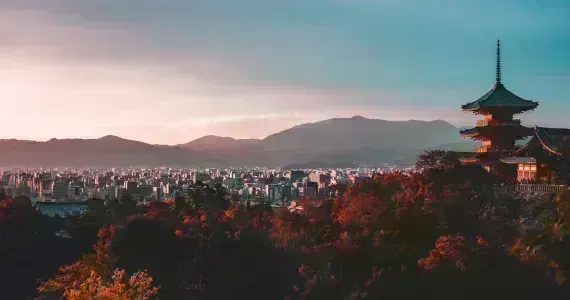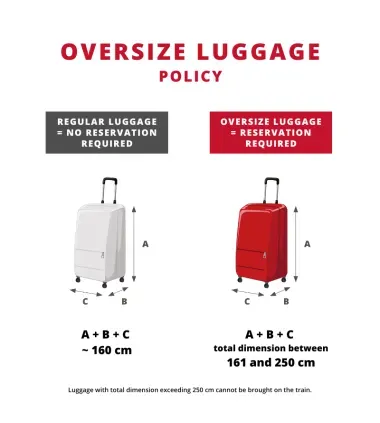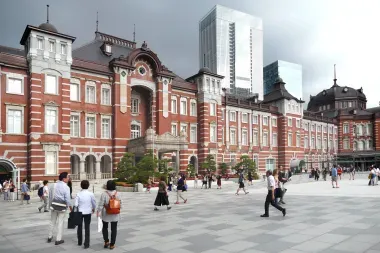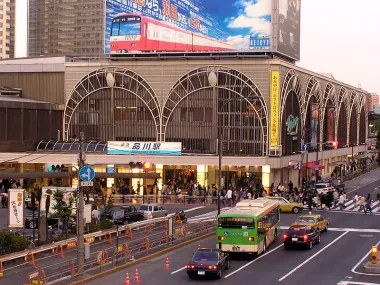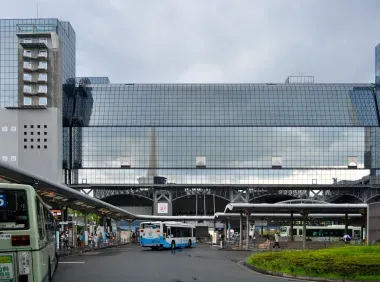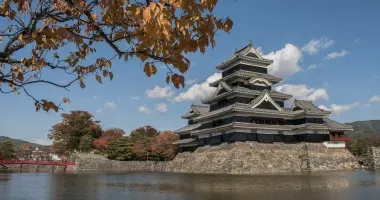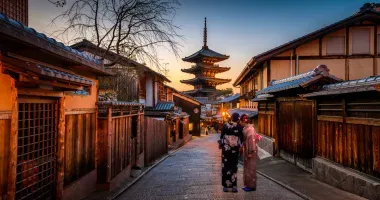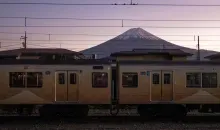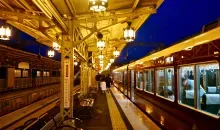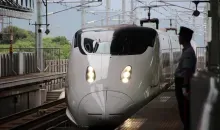How to get from Tokyo to Kyoto
The trip from the current capital of Tokyo to the ancient capital of Kyoto is a common journey for those traveling on Japan’s Golden Route, an itinerary popular with first-time visitors to Japan that is based off of a traditional trade road.
Going from Tokyo to Kyoto via Shinkansen bullet train
For many, the journey from Tokyo to Kyoto is most conveniently taken via the Tokaido-Sanyo Shinkansen bullet train that goes between Tokyo and Kyushu, Japan's most southern island. Taking, on average, a bit over two hours, it is a comfortable train ride that isn’t too demanding, with the beautiful scenery of Japan viewable from Shinkansen windows on the way there.
Travelers can purchase Shinkansen bullet train tickets and then depart from either Tokyo Station or Shinagawa Station (both within the central Tokyo area) and arrive at Kyoto Station. The trip can be made with an individual train ticket but is also fully covered by the Japan Rail Pass; however, an additional fee of 4,960 yen is required for those riding the Nozomi or Mizuho Shinkansen bullet trains. For both options, seats for you and your party can be made to assure a spot to sit. Note that for those with oversized luggage, a special seat next to a designated area for large baggage is required.
Tokaido-Sanyo Shinkansen bullet trains available on this itinerary:
| Nozomi Shinkansen Bullet Train | Mizuho Shinkansen Bullet Train | Hikari Shinkansen Bullet Train | Kodama Shinkansen Bullet Train |
*NOTE: All Shinkansen bullet trains on the Tokaido-Sanyo Line are accessible with the Japan Rail Pass; however, an additional fee of 4,960 yen is required to ride the Nozomi and Mizuho trains from Tokyo to Kyoto.
Purchase Shinkansen tickets from Tokyo to Kyoto!
Reserving seats on the Shinkansen
On Shinkansen bullet trains, there is the option to reserve seats prior to boarding for both those holding individual tickets and Japan Rail Passes. For many trains, reserving these seats isn't necessarily a requirement, as many Shinkansen bullet trains have non-reserved cars whose seats operate on a first-come, first-served basis. These are typically car numbers 1–4.
However, there are some trains where all cars require a reservation, and at the same time, we strongly suggest all travelers do their best to purchase tickets with a reservation during peak travel periods in Japan, such as the spring and during the New Year's season, as many are utilizing Shinkansen bullet train services during these times. When purchasing an individual ticket, a reserved seat constitutes an additional cost, but no such cost exists for Japan Rail Pass holders.
Oversized Baggage on the Shinkansen
For travelers with large baggage, there are certain requirements that must be met to bring it onto the bullet train. Per Japan Railway regulation, baggage that exceeds a sum of 160cm in dimension (L x W x H) must be placed in the designated oversized baggage section located in the back of the train car, and the owners of such baggage must reserve seats nearby this space. Note that any baggage that exceeds 250cm in total dimensions is not allowed on the Shinkansen at all.
Exceptions for these baggage rules include things like baby carriages, musical instruments in cases, and sports equipment (like bikes, snowboards, etc.) that are also in cases.
Exploring Tokyo
The modern-day capital of Japan was once known as Edo prior to the Meiji Restoration. It is currently the largest city in the world in terms of population and has a rich and varied culture that is representative of that. With hustle and bustle in its more central destinations and more sleepy, relaxed neighborhoods scattered around, there is something for everyone in this metropolitan area.
Lovers of anime and Japanese pop culture are sure to find a second home in Akihabara and Nakano. Those looking for a night out on the town will find constant entertainment in Roppongi. Trendy neighborhoods like Kichijoji and Shimokitazawa will give a peek into what the hip folk of Tokyo are into, and those wanting a day to treat themselves to luxury shopping and dining undoubtedly need to visit Ginza and Higashi Azabu.
One of Tokyo’s biggest draws is its extensive public transportation network, which will allow travelers to navigate around the city with ease. This is especially for holders of the JR Pass, who'll have unlimited access to the JR Lines within and departing from Tokyo. Tokyo Station, Shinagawa Station, and Ueno Station serve as Shinkansen Bullet Train stops.
To get to Kyoto from Tokyo, the Shinkansen bullet train is ridden from either Tokyo Station or Shinagawa Station (both in central Tokyo and both on the JR Yamanote Line). The surroundings of Tokyo Station are largely commercial, consisting of upscale, elegant shopping districts and department stores, restaurants that range from quick-eats to fine-dining, and tranquil parks such as Hibiya Park and the Imperial Palace Park. Within the station exists an extensive network of more shops and restaurants, as well as a few department stores.
Shinagawa Station exists in a more business-centric district with a number of affordable, fast-casual dining-oriented restaurants in the area to cater to office workers. However, there are a number of attractions that visitors or those waiting to board their departing Shinkansens can entertain themselves with, including the Maxell Aqua Park and Nikon Camera Museum.
Exploring Kyoto
Japan’s former capital, Kyoto, is home to 17 different UNESCO Heritage Sites, making it a culture-rich city that is teeming with history. Kyoto is often the destination after Tokyo for those traveling the Japan Golden Route, and it is located in the Kansai region, a culturally diverse part of Japan known for its eclectic destinations.
Of some of Kyoto’s most iconic destinations, the slope up to Kyomizudera and the temple itself are worthwhile adventures. Up to the temple, the hilly roads are lined with charming shops and restaurants, so don’t be afraid to explore a bit off the beaten path! Then, the “gold and silver temples” of Ginkakuji and Kinkakuji stand as powerful symbols of Kyoto's rich history. For a more understated location, the neighborhood of Kitaoji has a calmer atmosphere that is still blessed with a medley of traditional temples and even a neighborhood favorite onsen.
While still a city, Kyoto differs from other major cities in Japan with the absence of towering skyscrapers; instead, it is surrounded by mountains on three sides and laced with traditional architecture. Take advantage of Kyoto’s unique geography and take the time to take a relaxing hike to enjoy the surrounding nature. The hike from Shogunzuka to Seiryuden is one of the easier hikes to do in the area and leads to Chion-in Temple in about two hours. Take in the unhindered view of the city from a high-elevation viewpoint and see Kyoto in a way that you’d never expect.
Traveling from Tokyo, arriving at Kyoto Station brings travelers right to the center of the ancient capital. The current iteration of the station was designed by acclaimed architect Hiroshi Hara and erected in 1997 to celebrate Kyoto's 1200th anniversary as a city, an accolade not many other cities in the world can claim. Not as large as Tokyo Station, the inside houses a few convenience stores, cafes, and restaurants. One of the most recognizable attractions attached to Kyoto Station, however, is the illuminated staircase, whose light display changes depending on the season. Also a short walk from the station and a great spot to kill some time and relax is the locally-beloved Ume-yu, a sento bathouse with a distinct feel and eccentric merchandise that exists in a residential area.
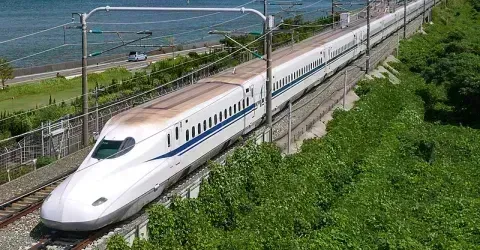
Shinkansen Nozomi
MaedaAkihiko, Wikimedia Commons
From one capital to another
Departing from Japan's previous capital for its modern one makes for a journey that puts the essence of Japan on full display. Via Tokyo, travelers can see an urban metropolis filled with endless hip neighborhoods that rapidly developed into a collection of countless buildings and skyscrapers. Kyoto is the gateway to the Japan of yesteryear that has been preserved over centuries and has still adapted to a modern world. To see one after the other provides insight into the evolution of the culture of Japan, seamlessly traveled between via the sensibilities of Japan's iconic Shinkansen bullet train.

